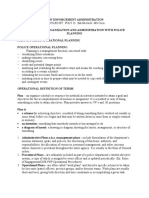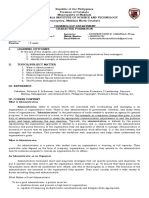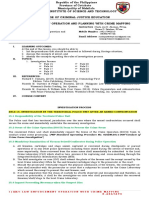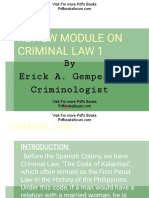LEA 4 - Module 3
Uploaded by
Anthony EhaponLEA 4 - Module 3
Uploaded by
Anthony EhaponRepublic of the Philippines
Province of Cotabato
Municipality of Makilala
MAKILALA INSTITUTE OF SCIENCE AND TECHNOLOGY
COLLEGE OF CRIMINAL JUSTICE EDUCATION
LAW ENFORCEMENT OPERATION AND PLANNING WITH CRIME MAPPING
Course Number : LEA 4 Instructors : Karla Joy D. Abatayo, RCrim.
Noime D. Petalino, RCrim.
Course Title : Law Enforcement Operation Mobile Number : 09217995810
and Planning with Crime Mapping 09395797748
Module : 3 Email Address : karlajoyabatayo.mist@gmail.com
Duration : 2 weeks noimepetalinorcrim@gmail.com
________________________________________________________________________________________________
I. LEARNING OUTCOMES:
At the end of this lesson, you should be able to:
1. determine the guidelines and procedures in conducting High risk stop and high risk arrest;
2. discuss the procedures in conducting defensive roadblocks; and
3. discuss the importance of defensive roadblocks.
II. TOPICS:
1. High risk stop and high risk arrest
2. Police Defensive Roadblock
III. REFERENCES:
Book Resources
Richard T. Camara, (2019). Outline Reviewer in Criminology First
Edition. Tetra Publishing, Davao City.
Ricardo M. Guevara & Felipe S. Bautista, (2013). Philippine Law Enforcement Administration.
Wiseman’s Books Trading, Inc. Quezon City.
Ricardo M. Guevara & William dela Cruz Vinas, (2015). Police Organization and Administration with
Police Planning Second Edition. Wiseman’s Book Trading, Inc. Quezon City.
IV. COURSE CONTENT
11.9 High risk stop and high risk arrest
a. Initial Stage
Upon receipt of information involving movement of armed
person or persons, either singly or in group, including
unauthorized movement of government troops, or in
immediate response to a reported commission of crime
perpetrated by armed persons, the PNP shall immediately:
1. Organize appropriate tactical security forces utilizing
maximum firepower and armor assets;
2. Deploy the security forces to stopping zones in defensive
position: and
3. Seal off the area and establish strong
roadblocks/barricades.
b. Effecting a High Risk Stop
When effecting high-risk stop, the police officer shall:
1. Exert utmost effort to persuade the suspects to halt or
stop their movement.
2. Start with the procedural conduct of regular warrantless arrest where arrest is inevitable.
3. Ensure proper documentation of the process.
4. Respect the rights of all the persons involved.
c. During Violent Stage
The PNP shall strictly adhere to the PNP Operational Procedures (POP), particularly on the use of
force (Rule 7).
1 | LEA 4 - L A W ENFORCEMENT OPERATION WITH CRIME MAPPING
K.ABATAYO
11.10 Police Defensive Roadblock
Police Defensive Roadblock is temporary installation or hastily built barricade set for halting
traffic to facilitate the apprehension/neutralization of an armed person/suspect on board a
motor vehicle. (PNP Command Memorandum Circular No. 25-13 “Establishment of Police
Defensive Roadblocks”
a. Pre-Conditions in Establishing Police Defensive Roadblocks:
A Police Defensive Roadblock may be established in any of the following conditions/situations:
1. The object of the vehicle/s must be the subject of a recent flash alarm;
2. The driver/occupants of the vehicle are presumed hostile and will not stop at the checkpoint;
3. The vehicle disregarded a police established checkpoint when flagged down;
4. The identified vehicle and occupants must be the subject of a police case/combat
operational plan;
5. There is unauthorized troop movement; or
6. There must be validated information on any of the following;
a. On-going hot pursuit/police chase;
b. Movement of suspected armed persons onboard a motor vehicle;
c. Report of suspected armed men who have just committed a crime;
d. Vehicle carrying escaped prisoner; or
e. Armed motorcycle riding criminals.
b. Procedures in Establishing Roadblock:
1. Before the roadblock:
a. Organize appropriate/sufficient police tactical security forces, utilizing maximum
firepower and armor assets (if any) with the following team composition:
i. Team Leader (TL) – shall lead and take responsibility in the conduct of
checkpoint preferably an officer with the rank of at least Police Inspector.
ii. Spotter – PNP personnel who will point/profile suspected vehicle subject for
roadblock;
iii. Spokesperson – TL or member who is in charge of communicating with the
motorist’s subject for roadblock;
iv. Sniper – to render the vehicle un-operational to avoid escape and provide
firepower support to neutralize armed and hostile suspects during firefight.
v. Investigation Sub-team – in charge of investigation and documentation of the
roadblock;
vi. Search/Arresting Sub-team – designated to conduct search, seizure and
arrest;
2 | LEA 4 - L A W ENFORCEMENT OPERATION WITH CRIME MAPPING
K.ABATAYO
vii. Security Sub-team – tasked to provide security in the roadblock area; and
ensure exclusion of other vehicles and civilians subject of roadblock;
viii. Blocking/Pursuing Sub-team – team tasked to block/pursue fleeing
suspects/vehicle.
ix. Medical Sub-team – tasked to provide immediate medical assistance if
necessary;
x. Additional tactical personnel/team may be employed depending on the size of
the hostiles; and
xi. Videographer – tasked to take videos of the entire roadblock operation.
b. The TEAM LEADER (TL) shall brief the elements/members of the Police Roadblock and
perform the following:
i. Inform the next higher Headquarters of the make or type and plate number of
the motor vehicle ;
ii. Coordinate with the Chief of Police and friendly forces who has territorial
jurisdiction over that area; and
iii. Immediately contact adjacent units to inform them of the situation so that these
units can conduct dragnet operation, while the members of the
blocking/pursuing team shall block or pursue the fleeing suspects/vehicle.
c. Participating personnel in the roadblock must be in their prescribed uniform; and
d. In a roadblock, since troop deployment is urgent and public safety is at risk, the
participation of civilian component and the presence of media in the roadblock shall
not be allowed.
2. During the Roadblock:
a. Establish forward observers/spotters and rear checkpoint;
b. Deploy security forces in a strategic and defensive position;
c. Establish a strong roadblock on selected strategic areas;
d. Deploy road spikes or tire deflation system if available;
e. Ensure that the whole intervention procedure is documented by the videographer;
f. As much as possible, the area where the roadblock shall be established must be
properly lighted with noticeable signage bearing the name of the PNP Unit visibly
displayed and in a safe distance from a populated area to prevent collateral damage if
a firefight ensues.
g. Police car lights must be turned on at all times during the operation;
h. Identify yourself –rank, name, unit verbally and make known to the suspect/s that
you are after them through the use of a siren or megaphone.
i. If the vehicle’s windows are heavily tinted and the occupants cannot be seen, instruct
the driver to open all windows to have a clear view of the interior of the vehicle.
j. Instruct the driver to turn off the ignition (if this was not done when the vehicle
stopped) and order all the occupants to disembark followed by their hands to be
placed on top of the vehicle.
k. The other members of the team must be on guard for any eventually while the vehicle
is being approached;
l. Intervention procedures upon stop subject vehicle: Exert utmost effort to persuade the
suspects to halt or stop their movement;
3 | LEA 4 - L A W ENFORCEMENT OPERATION WITH CRIME MAPPING
K.ABATAYO
i. Start with the procedural conduct of regular warrantless arrest where arrest is
inevitable;
ii. Ensure proper documentation of the process; and
iii. Respect the rights of all the persons involves.
m. Procedures when suspects open fire/engage the troops:
i. In the event that the occupants of the vehicle open fire on the personnel
manning the roadblock, reasonable force to overcome the suspects’ aggression
may be employed;
ii. Use only necessary force to neutralized suspects;
iii. Prevent panic firing;
iv. Prevent collateral damage; and
v. Account for the casualties.
3. After the Roadblock:
a. When suspect/s surrendered or are
arrested:
i. Arrested persons must be
apprised of their rights in
reference to the Miranda
Doctrine; and
ii. An after Roadblock Operations
Report must be submitted to
their perspective units or
organizations for proper
evaluation of the efficacy of
the operation.
b. When suspects engage with troops:
i. Account for the casualties and give immediate medical assistance to the
wounded;
ii. Protect/preserve the crime scene/engagement area; and
iii. Ensure proper documentation of the process.
c. Fleeing vehicles:
i. In the event that the motor vehicle did not stop and it evaded the roadblock
despite the warning given, inform Headquarter or adjacent units so that
another roadblock can be set-up;
ii. Fleeing vehicles shall not be fired upon except by a sniper but only to disable
the vehicle;
iii. Inform Headquarters of the make or type , plate number and color of the motor
vehicle to be accosted including the number of occupants and, if possible, their
identity;
iv. State the reason(s) for flagging down the suspected motor vehicle;
v. Give mobile car’s location and its direction before making actual intervention;
and
vi. Establish Hot Pursuit Operation.
4 | LEA 4 - L A W ENFORCEMENT OPERATION WITH CRIME MAPPING
K.ABATAYO
V. ACTIVITY/EXERCISE
Name:___________________________________________________________Year & Section:__________
Instructor: KARLA JOY ABATAYO/NOIME PETALINO Module No. 3
Explain each item below in 3-5 sentences. You may submit a hardcopy format at the campus, or a softcopy
format thru the link posted in our FB group or page.
1. How to conduct police defensive roadblocks?
2. What are the purposes of roadblocks?
VI. ASSESSMENT/EVALUATION
Direction: Read the questions carefully. Encircle the letter of your choice. You may submit a hardcopy
format at the campus, or a softcopy format thru the link posted in our FB group or Google classroom.
1. Upon the receipt of the information about unauthorized movement of government troops or a
reported crime done by armed individuals. The PNP shall conduct immediately the following,
except one;
A. Ensure the proper documentation of the process.
B. Organize appropriate tactical security forces utilizing maximum firepower and armor
assets.
C. Deploy the security forces to stopping zones in defensive position.
D. Seal off the area and establish strong roadblocks/barricades.
2. To ensure an effective high risk stop, an officer must perform the following, except one;
A. Shall strictly adhere to the PNP Operational Procedures (POP), particularly on the use
of force.
B. Exert utmost effort to persuade the suspects to halt or stop their movement.
C. Start with the procedural conduct of regular warrantless arrest where arrest is
inevitable.
D. Ensure proper documentation of the process.
E. Respect the rights of all the persons involved.
3. One of the following is a condition in establishing police defensive roadblock;
A. Deploy road spikes
B. Ongoing hot pursuit
C. Flag down
D. Search and seizure
4. One of the following incidents could unpredictably happen after roadblocks, except one;
A. When suspects surrendered or arrested
B. When the suspects engage with troops
C. Fleeing vehicles
D. Flagging down individuals/motor vehicles
5. During roadblocks, if the suspected individuals open fire, what will you do?
A. Use only necessary force to neutralized suspects
B. Prevent panic firing
C. Prevent collateral damage
D. Account for the casualties
E. Arrest the persons involved
5 | LEA 4 - L A W ENFORCEMENT OPERATION WITH CRIME MAPPING
K.ABATAYO
You might also like
- LAW ENFORCEMENT OPERATIONS AND PLANNING WITH CRIME MAPPING Send 2No ratings yetLAW ENFORCEMENT OPERATIONS AND PLANNING WITH CRIME MAPPING Send 24 pages
- LEA 4 Law Enforcement Operations and Planning With Crime MappingNo ratings yetLEA 4 Law Enforcement Operations and Planning With Crime Mapping39 pages
- Module 1 - Law Enforcement Operations and Planning With Crime MappingNo ratings yetModule 1 - Law Enforcement Operations and Planning With Crime Mapping4 pages
- Crowd Control and Riot Prevention Definition of Terms: Lea 3 (Law Enforcement Operation Planning With Crime Mapping)No ratings yetCrowd Control and Riot Prevention Definition of Terms: Lea 3 (Law Enforcement Operation Planning With Crime Mapping)17 pages
- Chapter I: Importance of Personal Identification in Criminal InvestigationNo ratings yetChapter I: Importance of Personal Identification in Criminal Investigation3 pages
- Law Enforcement Operations and Planning With Crime Mapping: Prepared By: John Patrick B. de Jesus100% (1)Law Enforcement Operations and Planning With Crime Mapping: Prepared By: John Patrick B. de Jesus20 pages
- Character Formation 2 - Leadership, Decision Making, Management and Administration Learning ModuleNo ratings yetCharacter Formation 2 - Leadership, Decision Making, Management and Administration Learning Module10 pages
- PNP Policing and Inter Agency Approach With Specialized Law Enforcement Agencies100% (1)PNP Policing and Inter Agency Approach With Specialized Law Enforcement Agencies3 pages
- Module Ii Powers and Functions Organizational Structure and Responsibilities of Various Law Enforcement and Public Safety AgenciesNo ratings yetModule Ii Powers and Functions Organizational Structure and Responsibilities of Various Law Enforcement and Public Safety Agencies20 pages
- RecoRding Living and PostmoRtem Friction Ridge ExemplaRsNo ratings yetRecoRding Living and PostmoRtem Friction Ridge ExemplaRs18 pages
- Police Patrol Operations With Police Communications System 2No ratings yetPolice Patrol Operations With Police Communications System 25 pages
- Specialized Crime Investigation: With Legal MedicineNo ratings yetSpecialized Crime Investigation: With Legal Medicine4 pages
- Philippine Criminal Justice System and Human RightsNo ratings yetPhilippine Criminal Justice System and Human Rights6 pages
- Cdi 3 Lesson 8 - Raid Search and SeizureNo ratings yetCdi 3 Lesson 8 - Raid Search and Seizure58 pages
- CFLM 1 - Lesson 2 NATIONAL HISTORICAL INSTITUTENo ratings yetCFLM 1 - Lesson 2 NATIONAL HISTORICAL INSTITUTE5 pages
- Law Enforcement Operations and Planning With Crime Mapping: Prepared By: Bryan T.BaconguisNo ratings yetLaw Enforcement Operations and Planning With Crime Mapping: Prepared By: Bryan T.Baconguis141 pages
- Police Critical Incident Management G 1 4aNo ratings yetPolice Critical Incident Management G 1 4a21 pages
- Lea 4 - Law Enforcement Operations & Planning With Crime Mapping (Obe-Cmo 5, S2018) Prelim Coverage - Week 1No ratings yetLea 4 - Law Enforcement Operations & Planning With Crime Mapping (Obe-Cmo 5, S2018) Prelim Coverage - Week 14 pages
- Cdi Fundamentals of Criminal Investigation and IntelligenceNo ratings yetCdi Fundamentals of Criminal Investigation and Intelligence148 pages
- CCJ 2018 CDI3 Special-Crime-Investigation-2No ratings yetCCJ 2018 CDI3 Special-Crime-Investigation-29 pages
- 1 - Cdi-7 Drug Education and Vice ControlNo ratings yet1 - Cdi-7 Drug Education and Vice Control3 pages
- 1 - Cdi-7 Drug Education and Vice ControlNo ratings yet1 - Cdi-7 Drug Education and Vice Control6 pages
- LAW ENFORCEMENT OPERATIONS AND PLANNING WITH CRIME MAPPING Send 2LAW ENFORCEMENT OPERATIONS AND PLANNING WITH CRIME MAPPING Send 2
- LEA 4 Law Enforcement Operations and Planning With Crime MappingLEA 4 Law Enforcement Operations and Planning With Crime Mapping
- Module 1 - Law Enforcement Operations and Planning With Crime MappingModule 1 - Law Enforcement Operations and Planning With Crime Mapping
- Crowd Control and Riot Prevention Definition of Terms: Lea 3 (Law Enforcement Operation Planning With Crime Mapping)Crowd Control and Riot Prevention Definition of Terms: Lea 3 (Law Enforcement Operation Planning With Crime Mapping)
- Chapter I: Importance of Personal Identification in Criminal InvestigationChapter I: Importance of Personal Identification in Criminal Investigation
- Law Enforcement Operations and Planning With Crime Mapping: Prepared By: John Patrick B. de JesusLaw Enforcement Operations and Planning With Crime Mapping: Prepared By: John Patrick B. de Jesus
- Character Formation 2 - Leadership, Decision Making, Management and Administration Learning ModuleCharacter Formation 2 - Leadership, Decision Making, Management and Administration Learning Module
- PNP Policing and Inter Agency Approach With Specialized Law Enforcement AgenciesPNP Policing and Inter Agency Approach With Specialized Law Enforcement Agencies
- Module Ii Powers and Functions Organizational Structure and Responsibilities of Various Law Enforcement and Public Safety AgenciesModule Ii Powers and Functions Organizational Structure and Responsibilities of Various Law Enforcement and Public Safety Agencies
- RecoRding Living and PostmoRtem Friction Ridge ExemplaRsRecoRding Living and PostmoRtem Friction Ridge ExemplaRs
- Police Patrol Operations With Police Communications System 2Police Patrol Operations With Police Communications System 2
- Specialized Crime Investigation: With Legal MedicineSpecialized Crime Investigation: With Legal Medicine
- Philippine Criminal Justice System and Human RightsPhilippine Criminal Justice System and Human Rights
- Law Enforcement Operations and Planning With Crime Mapping: Prepared By: Bryan T.BaconguisLaw Enforcement Operations and Planning With Crime Mapping: Prepared By: Bryan T.Baconguis
- Lea 4 - Law Enforcement Operations & Planning With Crime Mapping (Obe-Cmo 5, S2018) Prelim Coverage - Week 1Lea 4 - Law Enforcement Operations & Planning With Crime Mapping (Obe-Cmo 5, S2018) Prelim Coverage - Week 1
- Cdi Fundamentals of Criminal Investigation and IntelligenceCdi Fundamentals of Criminal Investigation and Intelligence











































































